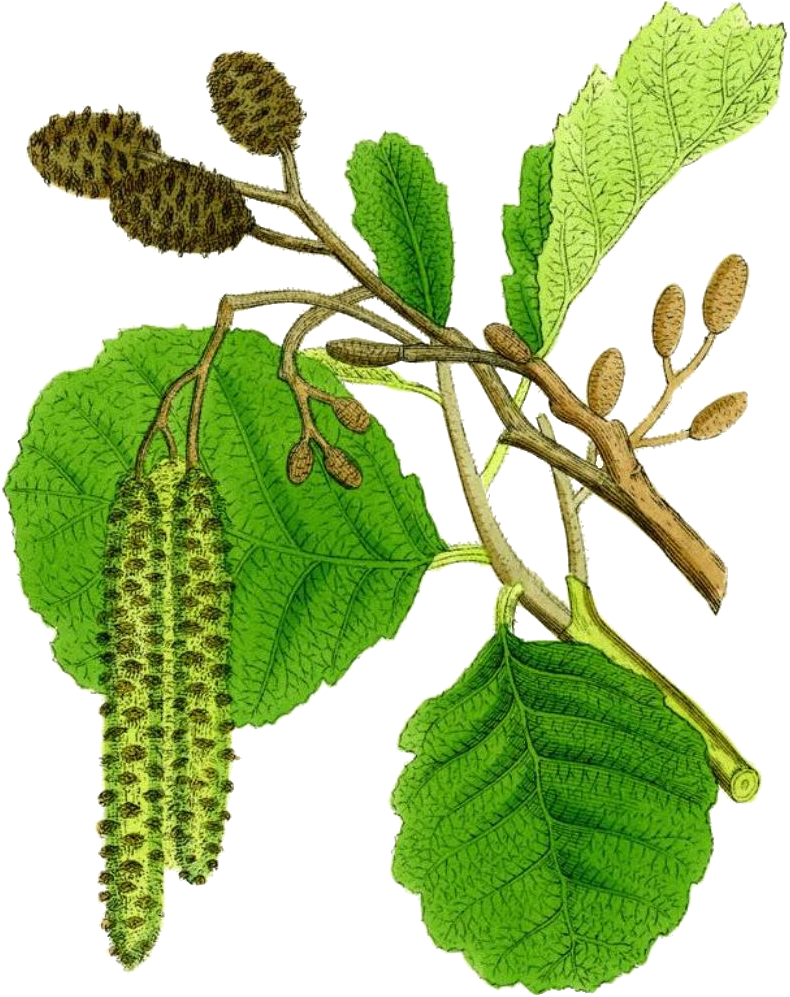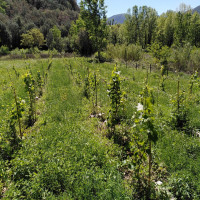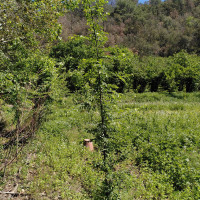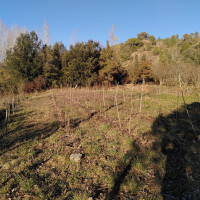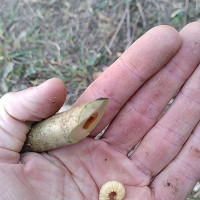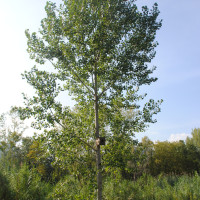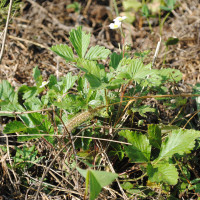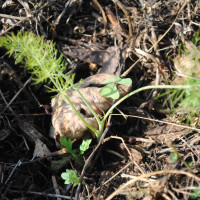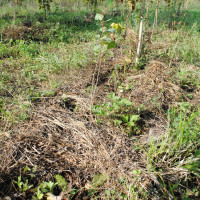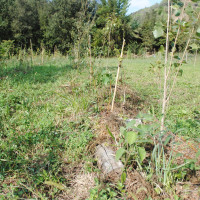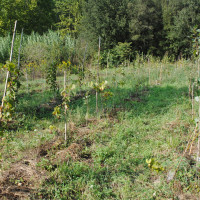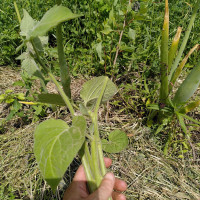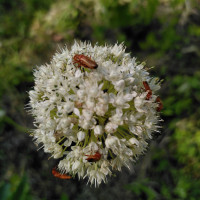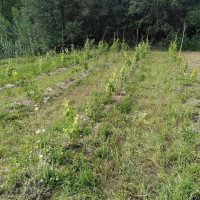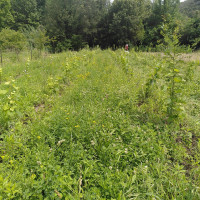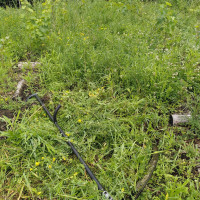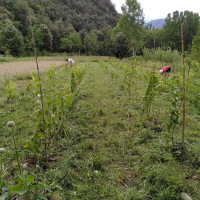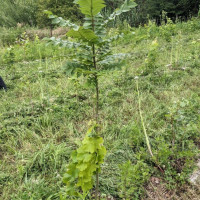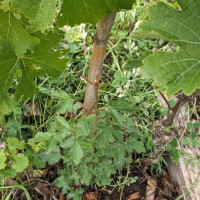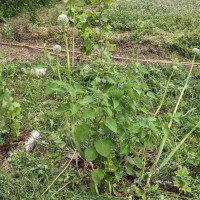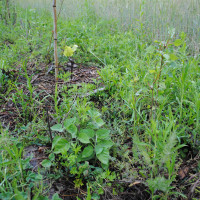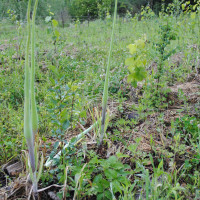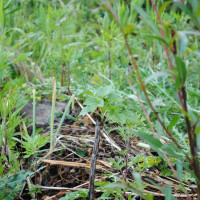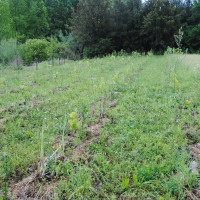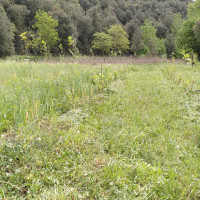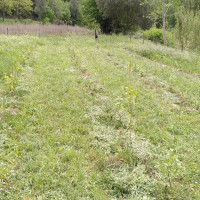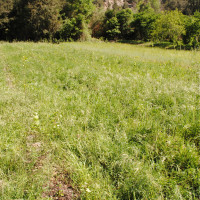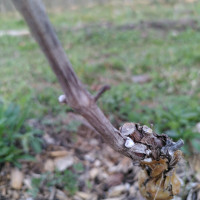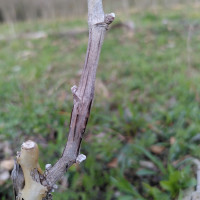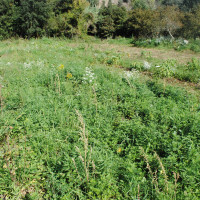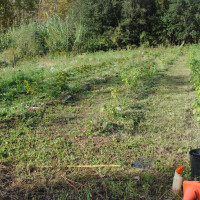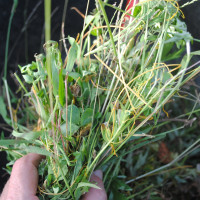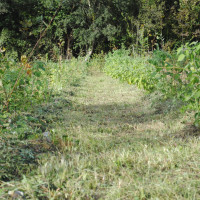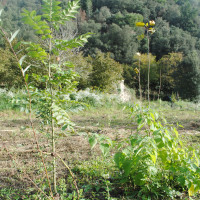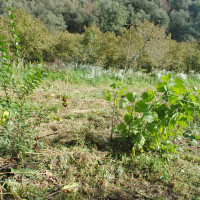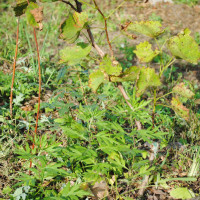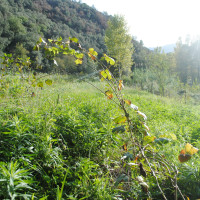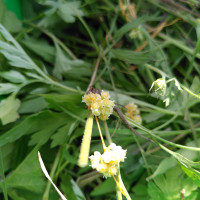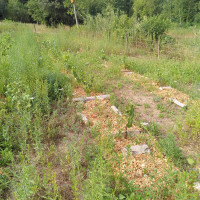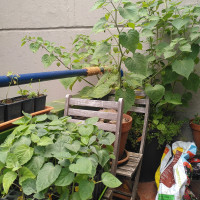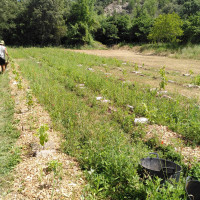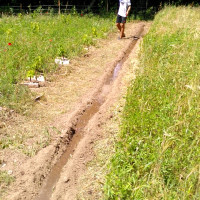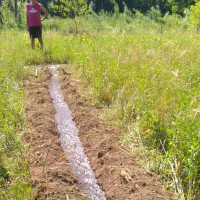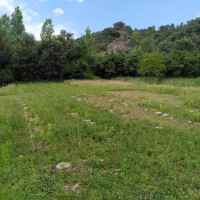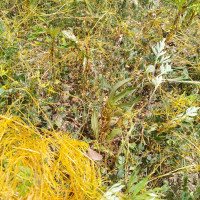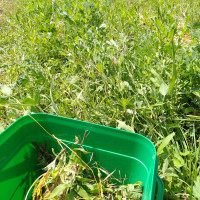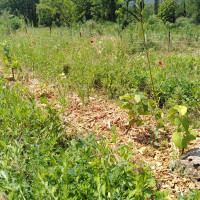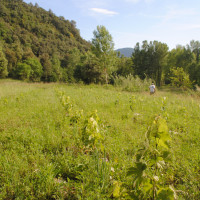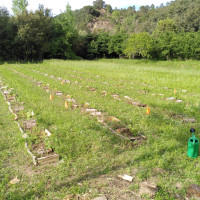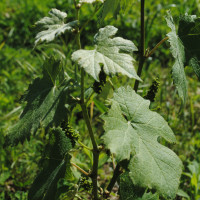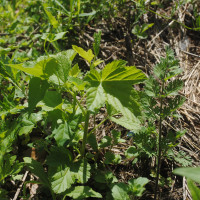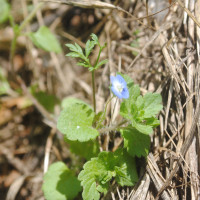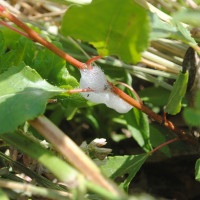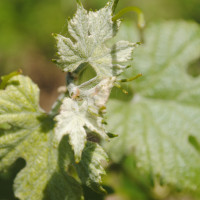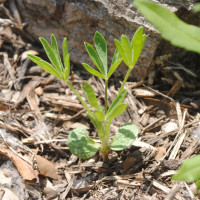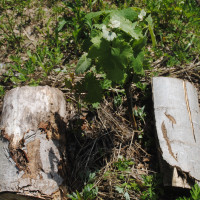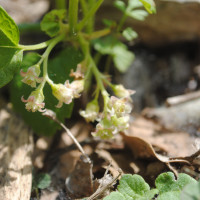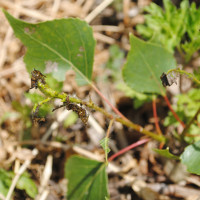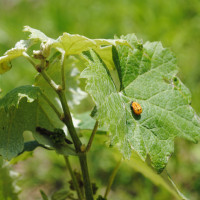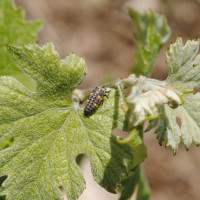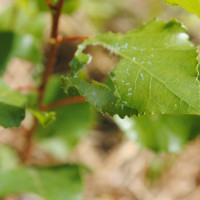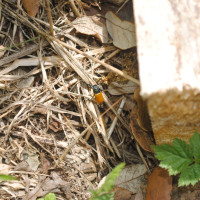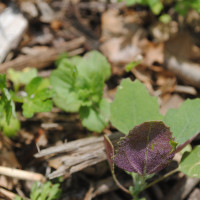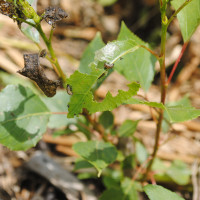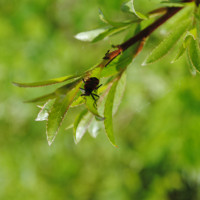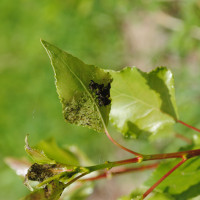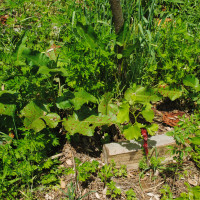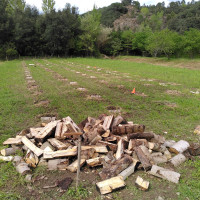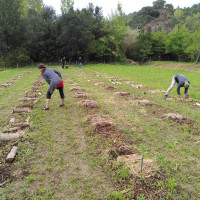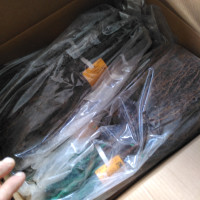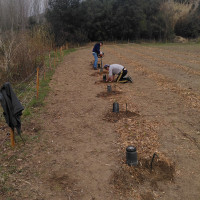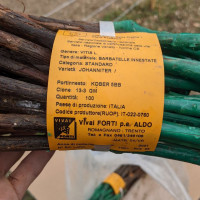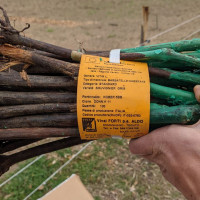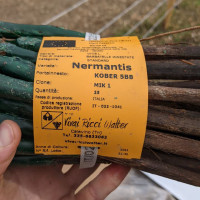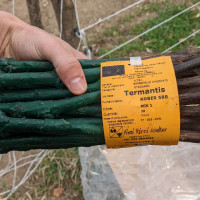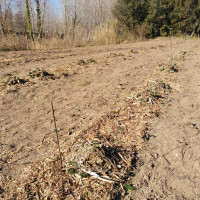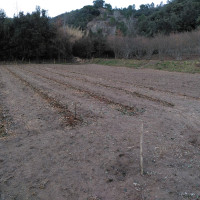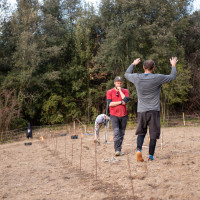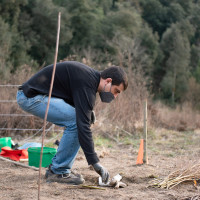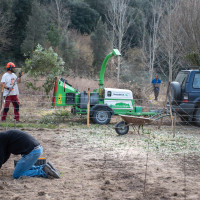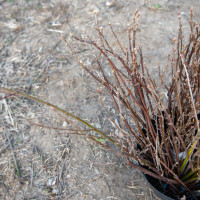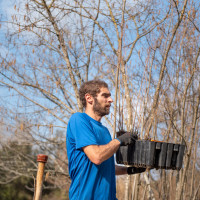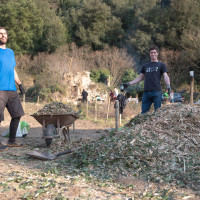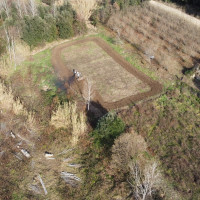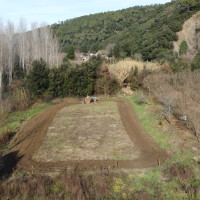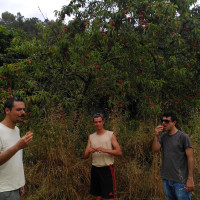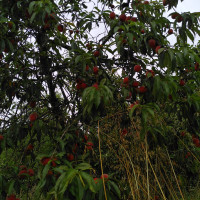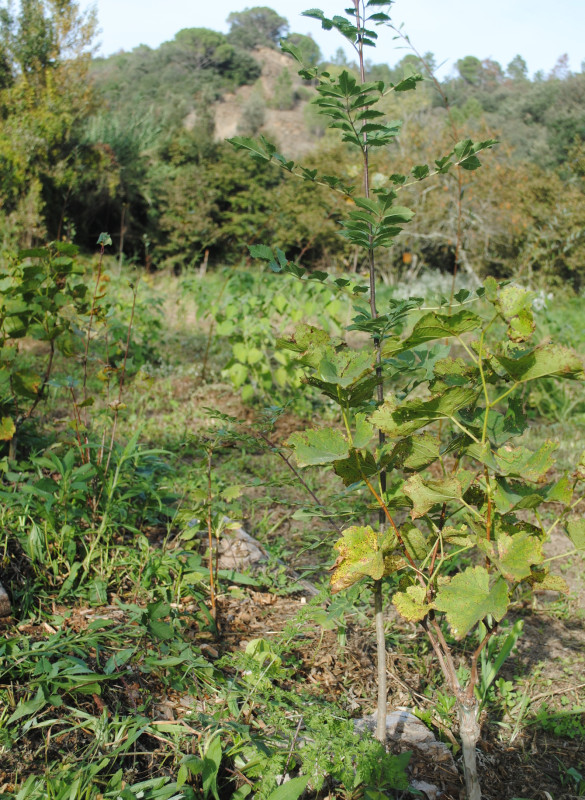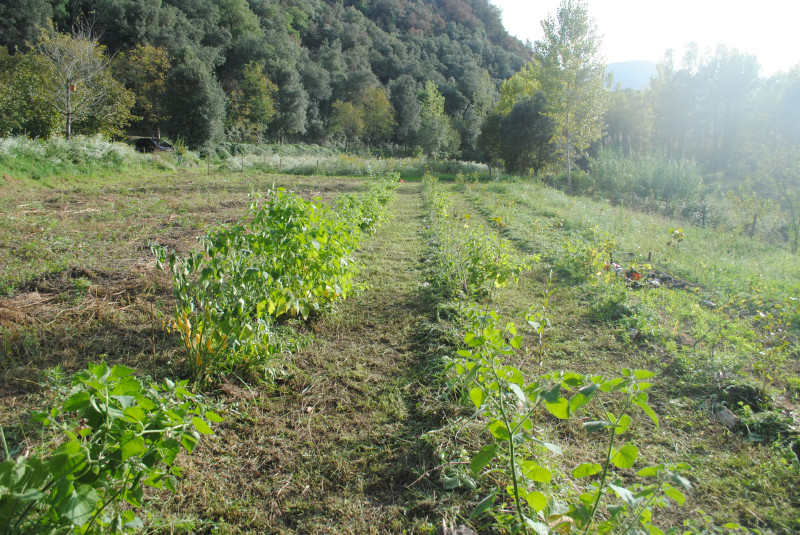Syntropic 1: Vineyard
A fungicide-free plantation where dense root systems improve soil aeration and vines are tutored on trees for natural support.
The design is inspired by Ernst Gotsch's work on Syntropic Agroforestry. The main pioneers are the Poplar and Physalis. Salix Alba acts as a first possible tutor for the vines and also as a pioneer.
The inter-row ground cover is grass and alfalta, cut before the last rains of spring, after the first rain at end of summer, and end of fall and/or end of winter. A scythe is used for a clean cut which promotes faster healing and re-growth. The biomass is raked to the margins of the main rows for weed supression and fertilizing.
Vines spacing is 2 by 2 meters.
Supporting plants
| Species variety | Var | Leafing | Flowering | Fruiting | ||||||||||||||||||||||||||||||||||||
|---|---|---|---|---|---|---|---|---|---|---|---|---|---|---|---|---|---|---|---|---|---|---|---|---|---|---|---|---|---|---|---|---|---|---|---|---|---|---|---|---|
Populus nigra |
|
|
| |||||||||||||||||||||||||||||||||||||
Physalis peruviana |
|
|
| |||||||||||||||||||||||||||||||||||||
Foeniculum vulgare |
|
|
|
| Species variety | Tip | Qty | Introduction | Phase-out | Propagation | Medium | Supplier |
|---|---|---|---|---|---|---|---|
Populus nigra | Populus and Salix cutting propogation: Las estacas de Populus y Salix hay que prepararlas cuando no tienen hojas, a sabia parada. Igualmente, el brote que te puedan hacer ahora no estará lignificado y con el frío del invierno se puede quemar. Estas estacas enraizaran y brotaran en primavera, por lo que en invierno poco van a hacer. [Plant supplier / nursery] Q__ La estaca de Populus/Salix, tiene que ser del año de crecimiento o puede ser de 2/3 años? Puede ser de 2/3 años. A__ Nosotros lo hacemos en alveolo forestal, por lo que utilizamos estacas delgadas, del año, pero en campo es conveniente ponerlas más gordas para que tengan más reservas y aguanten el terreno. Q__ Y se puede enterrar/clavar la estaca muy profundo, como 40-50cm o más? Se puede pudrir? A__Sí, se puede pudrir, sobretodo si hay agua estancada durante muchos días. Yo intentaría clavarlas en febrero para que estén el menor tiempo enterradas y sin brotar. [Plant supplier / nursery][naturalea.eu] Poplar's high water content can cause Frost crack when too cold. Can hybrid poplars have less or more resistance? Thorny branches can help protect seedlings from boars or deer. Having a diversity of support species can reduce the animal's focus on the cash crop. Trees with fibrous root structures (poplars, acacias, oaks) are able to improve soil though growth and dieback every year, not the case with every species. Is this related to the tree being deciduous or its ability to re-grow after pruning? [youtu.be] Cuttings directly on the ground need a wide area clearing and weed suppression, use large leaves and heavy thick mulch. [Can Neret] Deer likes young poplar leaves. Use very long cuttings to reduce risk. [Can Neret] Hybrid poplars grow much, much faster without weed competition. Plantings are made on bare ground and disced 4 times a year on the first year for this reason. Management is no longer required when undergrowth is shaded after 2nd year. [lignovis.com] | 95 | 2022-02-05 | Stem cutting | Cutting | Forestal Catalana | |
Physalis peruviana | Cuttings directly on the ground need a wide area clearing and weed suppression, use large leaves and heavy thick mulch. [Can Neret] | 95 | 2023-04-05 | Seed | Tray | ||
Foeniculum vulgare | 285 | 2023-10-07 | 2025-08-31 | Seed | Tray | Planters Casas |
| Species variety | Fnc | Strata | Top | Cut months | Light | Functions | |
|---|---|---|---|---|---|---|---|
Populus nigra | Pruning lower branches until reach height of 4 meters then coppice in April and November. | Emergent | 4m | Pollard [4,11] | ~50% | Pioneering | |
Physalis peruviana | Coppice after fruit harvest in July. Allow regrowth until winter, then coppice again. Will regrow next spring. | Understory | 1m | Coppice [7] | Pioneering | ||
Foeniculum vulgare | Testing if it helps improve conditions by retaining water in the dry periods and creating partial shade. | Undergrowth | 1.5m | Coppice [4,9] |
Vines and tutors
| Species variety | Var | Leafing | Flowering | Fruiting | ||||||||||||||||||||||||||||||||||||
|---|---|---|---|---|---|---|---|---|---|---|---|---|---|---|---|---|---|---|---|---|---|---|---|---|---|---|---|---|---|---|---|---|---|---|---|---|---|---|---|---|
Salix alba |
|
|
| |||||||||||||||||||||||||||||||||||||
Acer campestre |
|
|
| |||||||||||||||||||||||||||||||||||||
Fraxinus angustifolia |
|
|
| |||||||||||||||||||||||||||||||||||||
Fraxinus excelsior |
|
|
| |||||||||||||||||||||||||||||||||||||
Ulmus minor |
|
|
| |||||||||||||||||||||||||||||||||||||
Vitis vinifera Garnacha roja | Garnacha roja Garnacha roja cl. 148 / R110 0.35 cl. 163 2022/03/03 - Vivers de l'Emporda |
|
|
| ||||||||||||||||||||||||||||||||||||
Vitis vinifera Johanniter | Johanniter The wines are endowed with moderately strong, fruity aromas and with the right refreshing acidity. On the palate it recalls Pinot Grigio and Riesling with notes of quince, pear and mandarin. The aftertaste can be pleasantly spicy. It is ideal as a sparkling base. |
|
|
| ||||||||||||||||||||||||||||||||||||
Vitis vinifera Nermantis | Nermantis Grape variety suitable for red vinification with ripening around mid-September (in San Michele all’Adige) with possible aging. Notes of violets and red fruits. Variety with levels of Malvidina 3.5 diglucosides within the normal range. |
|
|
| ||||||||||||||||||||||||||||||||||||
Vitis vinifera Souvignier gris | Souvignier gris Neutral to slightly fruity. The fragrance displays delicate aromas of melon, apricot jam and quince juice. The taste is characterized by a fine and fruity acidity and a delicate tannic structure, which gives well-structured wines a persistent finish. |
|
|
| ||||||||||||||||||||||||||||||||||||
Vitis vinifera Termantis | Termantis Grape variety suitable for red vinification with ripening around the beginning of September (in San Michele all’Adige) with possible aging. Notes of violets and red fruits. Variety with levels of Malvidina 3.5 diglucosides within the normal range. |
|
|
|
| Species variety | Tip | Qty | Introduction | Phase-out | Propagation | Medium | Supplier |
|---|---|---|---|---|---|---|---|
Salix alba | Populus and Salix cutting propogation: Las estacas de Populus y Salix hay que prepararlas cuando no tienen hojas, a sabia parada. Igualmente, el brote que te puedan hacer ahora no estará lignificado y con el frío del invierno se puede quemar. Estas estacas enraizaran y brotaran en primavera, por lo que en invierno poco van a hacer. [Plant supplier / nursery] Q__ La estaca de Populus/Salix, tiene que ser del año de crecimiento o puede ser de 2/3 años? Puede ser de 2/3 años. A__ Nosotros lo hacemos en alveolo forestal, por lo que utilizamos estacas delgadas, del año, pero en campo es conveniente ponerlas más gordas para que tengan más reservas y aguanten el terreno. Q__ Y se puede enterrar/clavar la estaca muy profundo, como 40-50cm o más? Se puede pudrir? A__Sí, se puede pudrir, sobretodo si hay agua estancada durante muchos días. Yo intentaría clavarlas en febrero para que estén el menor tiempo enterradas y sin brotar. [Plant supplier / nursery][naturalea.eu] Cuttings directly on the ground need a wide area clearing and weed suppression, use large leaves and heavy thick mulch. [Can Neret] | 100 | 2022-02-05 | Stem cutting | Cutting | Forestal Catalana | |
Acer campestre | 50 | 2022-02-05 | Seed | Tray | Forestal Catalana | ||
Fraxinus angustifolia | 12 | 2022-02-05 | Seed | Tray | Forestal Catalana | ||
Fraxinus excelsior | It prefers moist or wet soil.
can grow in very acid soils.
wildlife.
Thrives in alkaline soils but not in shallow soils over chalk.
surprisingly tolerant of seasonally water-logged soils
frost-tender and so it is best to grow the plants in a position sheltered from the early morning sun.
A fast growing tree.
Very tolerant of cutting.
light canopy and cast little shade. [pfaf.org] | 13 | 2022-02-05 | Seed | Tray | Forestal Catalana | |
Ulmus minor | Tap root, can grow in heavy clay soil, can grow in semi-shade. A good tree for growing grapes into. [pfaf.org] | 25 | 2022-02-05 | Seed | Tray | Viver Tres Turons | |
Vitis vinifera Garnacha roja | Grapes benefit from shade in very hot days. Fruit can be damaged by excess heat and sun. [Plant supplier / nursery] Vine roots grow deeper when surrounded by weeds [Plant supplier / nursery] | 20 | 2022-03-03 | Graft | Bare-root | Vivers de l'Empordà | |
Vitis vinifera Johanniter | Grapes benefit from shade in very hot days. Fruit can be damaged by excess heat and sun. [Plant supplier / nursery] Vine roots grow deeper when surrounded by weeds [Plant supplier / nursery] | 20 | 2022-02-25 | Graft | Bare-root | Vivai Forti (IT) | |
Vitis vinifera Nermantis | Grapes benefit from shade in very hot days. Fruit can be damaged by excess heat and sun. [Plant supplier / nursery] Vine roots grow deeper when surrounded by weeds [Plant supplier / nursery] | 20 | 2022-02-25 | Graft | Bare-root | Vivai Forti (IT) | |
Vitis vinifera Souvignier gris | Grapes benefit from shade in very hot days. Fruit can be damaged by excess heat and sun. [Plant supplier / nursery] Vine roots grow deeper when surrounded by weeds [Plant supplier / nursery] | 20 | 2022-02-25 | Graft | Bare-root | Vivai Forti (IT) | |
Vitis vinifera Termantis | Grapes benefit from shade in very hot days. Fruit can be damaged by excess heat and sun. [Plant supplier / nursery] Vine roots grow deeper when surrounded by weeds [Plant supplier / nursery] | 20 | 2022-02-25 | Graft | Bare-root | Vivai Forti (IT) |
| Species variety | Fnc | Strata | Top | Cut months | Light | Functions | |
|---|---|---|---|---|---|---|---|
Salix alba | Emergent | 2m | Prune | Living trellis, Pioneering | |||
Acer campestre | Canopy | 2m | Prune | ~50% | Living trellis | ||
Fraxinus angustifolia | Canopy | 2m | Prune | Living trellis | |||
Fraxinus excelsior | Canopy | 2m | Prune | Living trellis | |||
Ulmus minor | Seed selection from a tree not affected by Dutch Elm Disease, possible resistance. | Canopy | 2m | Prune | Living trellis | ||
Vitis vinifera Garnacha roja | Row 5. This is the control group, it is a common variety not selective fungus resistant. | Climber | 2m | Prune | ~50% | ||
Vitis vinifera Johanniter | Row 4 | Climber | 2m | Prune | ~50% | ||
Vitis vinifera Nermantis | Row 1 (riverside) | Climber | 2m | Prune | ~50% | ||
Vitis vinifera Souvignier gris | Row 3 | Climber | 2m | Prune | ~50% | ||
Vitis vinifera Termantis | Row 2 | Climber | 2m | Prune | ~50% |
Project Log
2024 week 16 20/5°C, 3.2mm
2024 week 15 24/7°C, 9.3mm
2024 week 14 23/7°C, 0mm
2024 week 13 19/8°C, 36.8mm
2024 week 12 22/9°C, 0mm
VInes and Ulmus minor early season growth
2023 week 46 26/7°C, 0mm
2023 week 45 19/7°C, 0.1mm
2023 week 44 22/8°C, 0.7mm
2023 week 43 25/14°C, 2.1mm
2023 week 42 24/12°C, 5mm
Planted longer poplar cuttings (Nov 14). A few wider cuttings had this resident.
2023 week 40 28/14°C, 0.1mm
2023 week 39 30/13°C, 0mm
2023 week 38 27/14°C, 6.7mm
2023 week 37 30/16°C, 36.8mm
2023 week 36 32/13°C, 0mm
The large poplar created afternoon shade in part of the plantation (non-irrigated) where increased ground moisture was observed. Planted 3x Foeniculum vulgare between vines (plugs).
2023 week 23 28/14°C, 4.2mm
2023 week 22 26/12°C, 17.8mm
2023 week 21 26/12°C, 46mm
2023 week 20 23/8°C, 6.4mm
2023 week 19 23/10°C, 63.1mm
Physalis propagation by cuttings. Bugs on onion flower.
2023 week 23 27/13°C, 4.2mm
2023 week 22 26/12°C, 17.8mm
2023 week 21 26/12°C, 46mm
2023 week 20 23/8°C, 6.4mm
2023 week 19 23/10°C, 63.1mm
Provisional tutoring
2023 week 19 23/11°C, 55mm
2023 week 18 26/9°C, 16.1mm
2023 week 17 25/11°C, 10.2mm
2023 week 16 23/6°C, 6.8mm
2023 week 15 22/5°C, 0.9mm
Physalis peruviana had 30% regrowth since fall (pruned at 20cm). Sorghum hybrid and Crotalaria juncea was seeded 2023-05-06 to develop the "placenta" of the planting.
2023 week 17 25/10°C, 6.6mm
2023 week 16 23/6°C, 6.8mm
2023 week 15 22/5°C, 0.9mm
2023 week 14 20/3°C, 0mm
2023 week 13 21/5°C, 3.6mm
Inter-rows cutting with scythe and biomass distribution.
2023 week 10 21/4°C, 0mm
2023 week 09 14/-0°C, 0.4mm
2023 week 08 16/4°C, 27.5mm
2023 week 07 18/-0°C, 0.2mm
2023 week 06 11/0°C, 43.4mm
Grape vine buds swelling
2022 week 43 28/11°C, 0mm
2022 week 42 27/13°C, 0.1mm
2022 week 41 26/12°C, 0.2mm
2022 week 40 24/12°C, 42.7mm
2022 week 39 25/10°C, 13.9mm
Fall growth, Ulmus and Fraxinus in moist soil has grown 1 meter in the season. An Acer campestre is catching up.
2022 week 29 36/18°C, 0mm
2022 week 28 37/19°C, 0mm
2022 week 27 35/17°C, 1.9mm
2022 week 26 32/16°C, 0.7mm
2022 week 25 32/16°C, 5.2mm
Cuscuta control, flowering spotted
2022 week 24 36/18°C, 0mm
2022 week 23 32/15°C, 2mm
2022 week 22 31/13°C, 0mm
2022 week 21 27/13°C, 15.5mm
2022 week 20 32/12°C, 0.1mm
Physalis peruviana planting
2022 week 23 31/14°C, 2mm
2022 week 22 31/13°C, 0mm
2022 week 21 27/13°C, 15.5mm
2022 week 20 32/12°C, 0.1mm
2022 week 19 28/11°C, 27mm
Opened unplanned irrigation canals.
2022 week 23 30/15°C, 2mm
2022 week 22 31/13°C, 0mm
2022 week 21 27/13°C, 15.5mm
2022 week 20 32/12°C, 0.1mm
2022 week 19 28/11°C, 27mm
Shredding to contain cuscuta exposed the soil causing drought, affecting all seedlings.
2022 week 22 31/13°C, 0mm
2022 week 21 27/13°C, 15.5mm
2022 week 20 32/12°C, 0.1mm
2022 week 19 28/11°C, 27mm
2022 week 18 24/10°C, 6.2mm
Cuscuta infestation. Unknown origin, likely from original barley seeding due to location and timing of appearance.
2022 week 22 28/12°C, 0mm
2022 week 21 27/13°C, 15.5mm
2022 week 20 32/12°C, 0.1mm
2022 week 19 28/11°C, 27mm
2022 week 18 24/10°C, 6.2mm
End of may,
2022 week 19 28/11°C, 27mm
2022 week 18 24/10°C, 6.2mm
2022 week 17 23/8°C, 13mm
2022 week 16 19/8°C, 47.8mm
2022 week 15 21/8°C, 5.6mm
Close-ups
2022 week 16 18/8°C, 47.5mm
2022 week 15 21/8°C, 5.6mm
2022 week 14 20/4°C, 12.6mm
2022 week 13 15/4°C, 24.4mm
2022 week 12 16/5°C, 15.2mm
Log splitting and distribution
2022 week 08 18/2°C, 0mm
2022 week 07 18/2°C, 3.1mm
2022 week 06 17/1°C, 0.1mm
2022 week 05 17/1°C, 0mm
2022 week 04 18/-2°C, 0.1mm
Vine planting
2022 week 06 18/-0°C, 0mm
2022 week 05 17/1°C, 0mm
2022 week 04 18/-2°C, 0.1mm
2022 week 03 14/-2°C, 0.1mm
2022 week 02 14/-2°C, 1.4mm
Biomass distribution
2022 week 05 18/0°C, 0mm
2022 week 04 18/-2°C, 0.1mm
2022 week 03 14/-2°C, 0.1mm
2022 week 02 14/-2°C, 1.4mm
2022 week 01 15/-0°C, 2.9mm
Planting before calçotada.
2021 week 52 20/8°C, 0mm
2021 week 51 16/2°C, 0.4mm
2021 week 50 16/-1°C, 0.4mm
2021 week 49 14/1°C, 0mm
2021 week 48 14/0°C, 0.5mm
Preparing the ground with a "fresadora".
Lessons
- Can Neret
[Irrigation] Have a plan for irrigation even if designing a no-irrigation system, as to give the plantation a chance to establish in the first years in case of drought. - Can Neret
[Reap/mow] When mowing the inter-rows or cover crop, make sure there is enough rain forecast for it to re-grow before summer drought. Having a low or no cover will increase the soil temperature and cause water loss affecting all plants in the area.(Dactylis glomerata ,Festuca arundinacea ,Medicago sativa) - Can Neret
[Stem cutting] Ribes nigrum cuttings were collected November 9th. Planted on the 12th/nov. They had roots late December.(Ribes nigrum ,Ribes rubrum) - Grapes benefit from shade in very hot days. Fruit can be damaged by excess heat and sun.Plant supplier / nursery
(Vitis vinifera) - Vine roots grow deeper when surrounded by weedsPlant supplier / nursery
(Vitis vinifera) - Can Neret
Plant supplier / nursery[Design] Shade from the west side can reduce ground water loss during the hot summer afternoons. When looking at cumulative hours, this can make a very big difference in long drought period.
